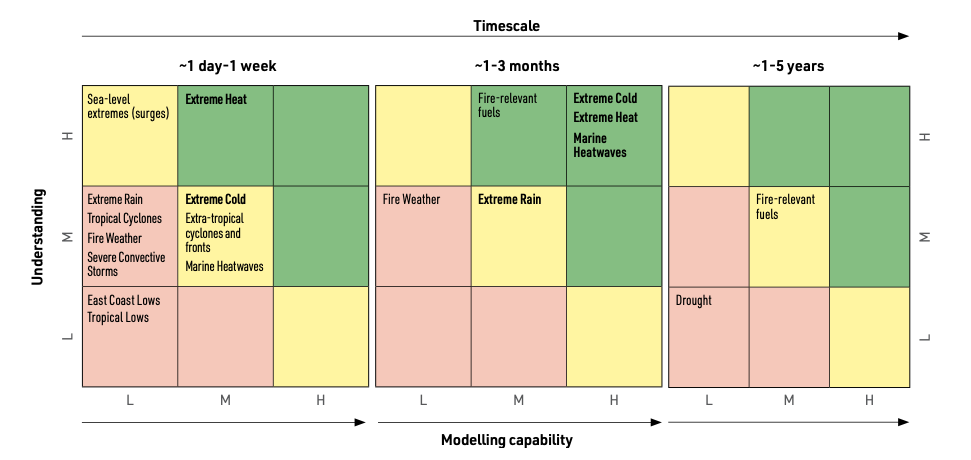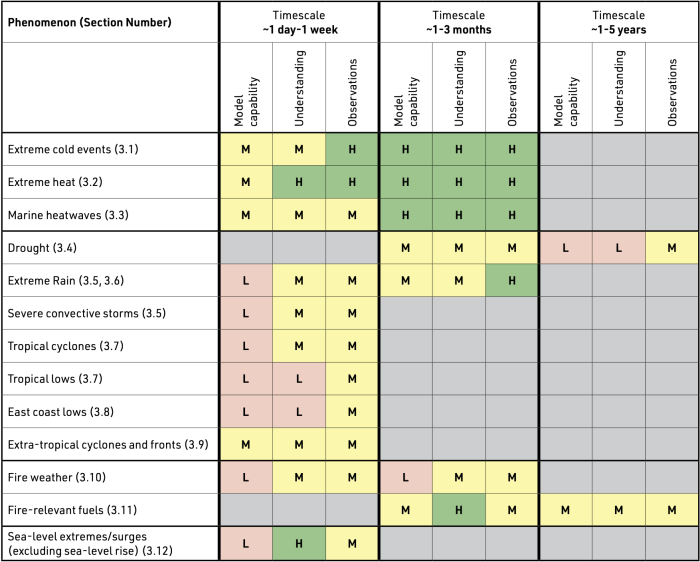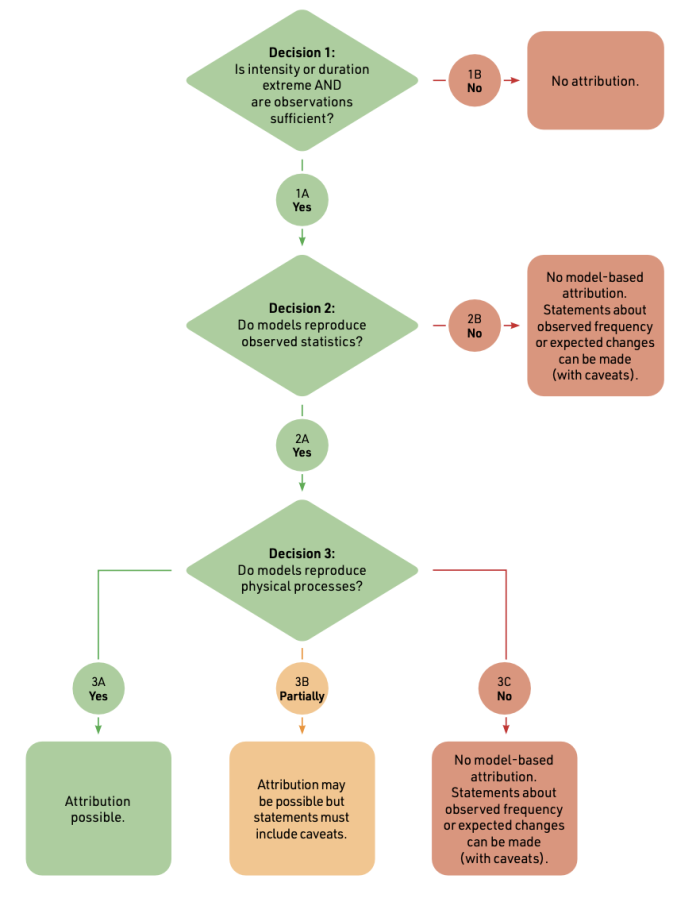- Event attribution is most robust when there are high-quality observations, when our climate models simulate relevant processes with skill, and when we have a good understanding of the critical processes underlying an event.
- Large-scale land and ocean- based heatwave events are well suited to event attribution studies and it may be possible to associate some fraction of these events to global warming robustly.
- Changes in east coast lows and severe convective storms are beyond our current capability to robustly determine the role of human activity.
- Long-term droughts are beyond our current capability to robustly determine the role of human activity.
- Robust event attribution science beyond heat events needs major improvements in climate model capability – work that is on-going across multiple groups in Australia and overseas.
What is attribution?
There are two types of “attribution” in climate science.
First, there is the question of whether an observed trend in a climate variable such as temperature, rainfall, or atmospheric pressure can be “detected” as separate from natural variability and then “attributed” to human emissions of greenhouse gases. This is called “detection and attribution”. This typically uses global or continental scale observations covering 50-100 years, can include theory and climate model experiments, and is relatively straightforward. This is why the Intergovernmental Panel on Climate Change (IPCC) can assess the state of climate science and conclude that humans have unequivocally caused global warming. In short, demonstrating that humans cause global warming is not contentious and is based on decades of robust and thorough science.
Second, is the rapidly growing field of extreme event attribution. This seeks to determine whether an event, whether a large-scale heatwave, cyclone, or severe storm has been affected by a particular influence on the climate, such as greenhouse gases from human activities.
There are lots of reasons for wanting to determine if a specific event is made worse by human-caused climate change, including ideas around linking damage to the industry or government associated with the emissions of greenhouse gases. For example, this could be used to directly attribute some percentage of a catastrophic event to emissions from a specific company which might form the basis of a damages claim through a court.
A great deal of media coverage either concludes, or hints at, a capability in climate science that some fraction of most catastrophic events can be attributed to human influence on the climate. This remains a point of discussion among climate scientists. Some climate scientists feel this is now possible (with caveats), and some feel it is beyond current capabilities (with occasional exceptions).
The ARC Centre of Excellence for Climate Extremes gathered experts across the field of climate science and event attribution to discuss the state of the science as it relates to Australia, which led to a peer reviewed publication1. Here we provide a summary of the published paper.
Attribution of climate extremes over Australia
Extreme weather events result from the interaction of multiple phenomena and processes, all occurring in a system perturbed by human-induced climate change. The behaviour and dominant mechanisms of different weather events vary by region. They depend on largescale climate variability and synoptic (or weather) scale processes. Moreover, depending on event types, there is varying scientific understanding of the influence of human-induced climate change, differing quality and quantity of observational records, and differing realism of their representation in climate models.
Robust event attribution studies require three key elements:
- robust observations,
- scientific understanding, and
- realistic climate modelling.
It is not really possible to precisely define what “robust observations”, “scientific understanding”, and “realistic climate modelling” mean, but it is possible to reach a consensus based on expert judgement using a diverse set of subject matter experts. The ARC Centre of Excellence for Climate Extremes undertook an assessment of whether our confidence in our observations, understanding and climate models were ‘low’, ‘medium’ or ‘high’. These findings are summarised in Figure 1.
Referring to Figure 1, phenomena located in the top-right of each 3 x 3 table are where we have high understanding of processes and high confidence in the capability of global climate models. This is similar to those used in international assessments (such as the Coupled Modelling Intercomparison Projects, CMIP) used in the IPCC assessments, to simulate the right phenomenon for the right reasons. These phenomena should be able to be attributed to climate change with the highest confidence.

This summary can be broken down into specific event types shown below in Table 1. There are a very clear set of phenomena, at a 1-3 month timescale, that we have high confidence in our models, our understanding and our observations. These all relate to temperature and include extreme cold events, extreme heat events, and marine heatwaves. We can have medium to high confidence around these events on a day-week timescale. In short, for temperature-associated extreme events there is capability to attribute them to human-induced climate change.
This capability extends to extreme rainfall and drought, albeit with a medium level of confidence in general, on the 1-3 month timescale and similarly to fire-related phenomenon.
However, as we move to short-duration rainfall events, our model capability becomes far more limited. This is because of the coarse resolution of our global climate models, coupled with limited understanding of some phenomena. This can be resolved to a significant degree by dramatically enhancing the spatial resolution of our climate models, something that is already happening for some event types, supported by scientific exploration of specific phenomena for which we have a low understanding.
The lack of understanding of multi-year droughts limits our capacity to attribute a specific drought event to global warming, and here it is unlikely that increasing the spatial resolution of our models will solve the problem. We likely first have to resolve our lack of understanding of what sustains some droughts over multiple years, as well as improving other aspects of climate models such as land-surface interaction models.

Table 1: Qualitative assessment of the ability of CMIP5/CMIP6 generation climate models to represent specific extremes (model capability), the level of understanding of the physical mechanisms that lead to changes in each extreme with human-induced climate change (understanding), and the quality and length of the observational record of each extreme (observations). Assessment categories correspond to confidence levels of high (H), medium (M), and low (L). Grey shading represents timescales that were not considered relevant for the specific extreme in the Australian context. Section numbers listed refer to the published paper.
The use of extreme event attribution over Australia, for critical phenomena including east coast lows, severe convective storms, long-term droughts, hail, and fire weather is beyond our current capability. However, the capability can be developed by on-going data collection, a program to improve our process-based understanding of what leads to extreme events and an ambitious program to develop global climate models utilising grid spacings of a few kilometres.
A lack of capability to attribute some types of single extreme event to climate change should not be interpreted, in any way, as evidence that anthropogenic climate change does not influence extreme events in Australia. There is well established evidence that anthropogenic climate change is affecting some extremes. However, at present we are unable to link some individual events with anthropogenic climate change at a level of scientific rigour or confidence that is required to make unambiguous statements.
The published paper explains the basis of the qualitative assessment shown in Table 1 case-by-case in detail. The paper provides a decision tree to:
- judge whether extreme event attribution is possible and
- help determine the level of confidence one might have in a statement made on event attribution (see Figure 2).

Figure 2: Graphical depiction of the generalised decision tree for event attribution.
A strict implementation of Figure 2 is likely to lead to robust extreme event attribution being quite rare for some phenomena, and a frustrating inability to make robust statements for many important events. So, what are the next steps?
Future Opportunities
There are no silver bullets to robust extreme event attribution, no single approach that resolves all the problems. Multiple lines of evidence, coupled with robust methods and full disclosure of uncertainties is required for all extreme events.
This implies the need for a properly organised and resourced long-term program of research and development to provide the foundation for extreme event attribution. Broadly, we suggest three strategies:
- Improve data collection, especially where this can improve our process-based understanding, to extend the observational record. A strategic use of remote sensing (such as satellites or radar), and targeted collection of paleoclimate proxies (for long term drought) would help improve our understanding of past events.
- Improve our understanding via process-based studies including far more dynamical and process-based analyses of extremes, focussed activities to examine very important extremes for which we lack even the most basic understanding. These include hailstorms, long term droughts and compound events for example.
- Develop and resource an ambitious program to dramatically improve our climate models, including the development and use of convection-permitting climate models for event attribution and models that employ a grid spacing of a few kilometres rather than the approximate 150 km currently used.
There are some immediate strategies to improve extreme event attribution in Australia. The lack of a silver-bullet or easy fix highlights the value of multi-method approaches to event attribution. This includes further exploration of the use of seasonal or weather prediction methods which help minimise uncertainties around modes of variability and have much more skill in simulating some phenomenon than the global climate models. We also need to develop impact-based event attribution analyses, including collaboration between impacts researchers and climate scientists, in particular in the common circumstance that an extreme event is caused by a compounding of factors.
Summary
The emergence of extreme event attribution is of considerable scientific interest and more broadly of great public, government and legal interest. However, the science around extreme event attribution is not yet robust for all extreme phenomena and conclusions around extreme event attribution can commonly be contested. It matters a great deal what the state of data are, what our physical understanding is, and how skilled our climate models are. Confident statements around extreme event attribution in Australia need to be treated with caution, in particular when they relate to phenomena other than temperature. However, on-going model development and model evaluation, coupled with increasing amounts of observational data do provide a pathway forward and robust event attribution is one of the long-term benefits of improving both modelling and data systems in the Australian context.
Reference list and author bios are available in the PDF version below.
